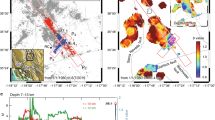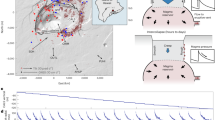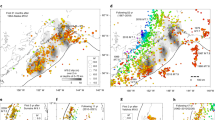Abstract
Earthquakes impart static and dynamic stress changes to the surrounding crust. Sudden fault slip causes small but permanent—static—stress changes, and passing seismic waves cause large, but brief and oscillatory—dynamic—stress changes. Because both static and dynamic stresses can trigger earthquakes within several rupture dimensions of a mainshock, it has proven difficult to disentangle their contributions to the triggering process1,2,3. However, only dynamic stress can trigger earthquakes far from the source4,5, and only static stress can create stress shadows, where the stress and thus the seismicity rate in the shadow area drops following an earthquake6,7,8,9. Here we calculate the stress imparted by the magnitude 6.1 Joshua Tree and nearby magnitude 7.3 Landers earthquakes that occurred in California in April and June 1992, respectively, and measure seismicity through time. We show that, where the aftershock zone of the first earthquake was subjected to a static stress increase from the second, the seismicity rate jumped. In contrast, where the aftershock zone of the first earthquake fell under the stress shadow of the second and static stress dropped, seismicity shut down. The arrest of seismicity implies that static stress is a requisite element of spatial clustering of large earthquakes and should be a constituent of hazard assessment.
This is a preview of subscription content, access via your institution
Access options
Subscribe to this journal
Receive 12 print issues and online access
$259.00 per year
only $21.58 per issue
Buy this article
- Purchase on Springer Link
- Instant access to full article PDF
Prices may be subject to local taxes which are calculated during checkout




Similar content being viewed by others
References
Kilb, D., Gomberg, J. & Bodin, P. Earthquake triggering by dynamic stresses. Nature 408, 570–574 (2000).
Freed, A. M. Earthquake triggering by static, dynamic, and postseismic stress transfer. Annu. Rev. Earth Planet. Sci. 33, 335–367 (2005).
Hill, D. P. & Prejean, S. G. in Treatise on Geophysics Vol. 4 (ed. Kanamori, H.) 257–291 (Elsevier, 2007).
Gomberg, J. & Johnson, P. Dynamic triggering of earthquakes. Nature 437, 830 (2005).
Velasco, A. A., Hernandez, S., Parsons, T. & Pankow, K. Global ubiquity of dynamic earthquake triggering. Nature Geosci. 1, 375–379 (2008).
Jaumé, S. C. & Sykes, L. R. Evolution of moderate seismicity in the San Francisco Bay region, 1850 to 1993: Seismicity changes related to the occurrence of large and great earthquakes. J. Geophys. Res. 101, 765–789 (1996).
Harris, R. A. & Simpson, R. W. In the shadow of 1857—the effect of the great Ft. Tejon earthquake on subsequent earthquakes in southern California. Geophys. Res. Lett. 23, 229–232 (1996).
Stein, R. S. The role of stress transfer in earthquake occurrence. Nature 402, 605–609 (1999).
Toda, S. & Stein, R. S. Toggling of seismicity by the 1997 Kagoshima earthquake couplet: A demonstration of time-dependent stress transfer. J. Geophys. Res. 109, B02303 (2003).
Wyss, M. & Wiemer, S. The change in the probability for earthquakes in southern California due to the Landers Magnitude 7.3 earthquake. Science 290, 1334–1338 (2000).
Toda, S. & Stein, R. S. Response of the San Andreas fault to the 1983 Coalinga–Nuñez Earthquakes: An application of interaction-based probabilities for Parkfield. J. Geophys. Res. 107, 2126 (2002).
Woessner, J., Hauksson, E., Wiemer, S. & Neukomm, S. The 1997 Kagoshima (Japan) earthquake doublet: A quantitative analysis of aftershock rate changes. Geophys. Res. Let. 31, L03605 (2004).
Daniel, G., Marsan, D. & Bouchon, M. Perturbation of the Izmit earthquake aftershock decaying activity following the 1992 Mw 7.2 Düzce, Turkey earthquake. J. Geophys. Res. 111, B05310 (2006).
Ma, K-F., Chan, C-H. & Stein, R. S. Response of seismicity to Coulomb stress triggers and shadows of the 1999 Mw=7.6 Chi-Chi, Taiwan, earthquake. J. Geophys. Res. 110, B05S19 (2005).
Kilb, D. A strong correlation between induced peak dynamic Coulomb stress change from the 1992 M7.3 Landers, California, earthquake and the hypocenter of the 1999 M7.1 Hector Mine, California earthquake. J. Geophys. Res. 108, 2012 (2003).
Felzer, K. R. & Brodsky, E. E. Testing the stress shadow hypothesis. J. Geophys. Res. 110, B05S09 (2005).
Mallman, E. P. & Zoback, M. D. Assessing elastic Coulomb stress transfer models using seismicity rates in southern California and southwestern Japan. J. Geophys. Res. 112, B03304 (2007).
Mallman, E. P. & Parsons, T. A Global search for stress shadows. J. Geophys. Res. 113, B12304 (2008).
Marsan, D. & Nalbant, S. Methods for measuring seismicity rate changes: A review and a study of how the Mw 7.3 Landers earthquake affected the aftershock sequence of the Mw 6.1 Joshua Tree earthquake. Pure Appl. Geophys. 162, 1151–1185 (2005).
Savage, J. C., Lisowski, M. & Murray, M. Deformation from 1973 through 1991 in the epicentral area of the 1992 Landers, California, earthquake (M s=7.5). J. Geophys. Res. 98, 19951–919958 (1993).
King, G. C. P., Stein, R. S. & Lin, J. Static stress changes and the triggering of earthquakes. Bull. Seismol. Soc. Am. 84, 935–953 (1994).
Wald, D. J. & Heaton, T. H. Spatial and temporal distribution of slip for the 1992 Landers, California earthquake. Bull. Seismol. Soc. Am. 84, 668–691 (1994).
Cohee, B. P. & Beroza, G. C. Slip distribution of the 1992 Landers earthquake and its implications for earthquake source mechanics. Bull. Seismol. Soc. Am. 84, 692–712 (1994).
Cotton, F. & Campillo, M. Frequency domain inversion of strong motions: Application to the 1992 Landers earthquake. J. Geophys. Res. 100, 3961–3975 (1995).
Hernandez, B., Cotton, F. & Campillo, M. Contribution of radar interferometry to a two-step inversion of the kinematic process of the 1992 Landers earthquake. J. Geophys. Res. 104, 13083–13099 (1999).
Dieterich, J. A constitutive law for rate of earthquake production and its application to earthquake clustering. J. Geophys. Res. 99, 2601–2618 (1994).
Marsan, D. Triggering of seismicity at short timescales following Californian earthquakes. J. Geophys. Res. 108, 2266 (2003).
Marsan, D. Can coseismic stress variability suppress seismicity shadows? Insights from a rate-and-state friction model. J. Geophys. Res. 111, B06305 (2006).
Steacy, S., Gomberg, J. & Cocco, M. Introduction to special section: Stress transfer, earthquake triggering, and time-dependent seismic hazard. J. Geophys. Res. 110, B05S01 (2005).
Cocco, M. et al. Sensitivity study of forecasted aftershock seismicity based on Coulomb stress calculation and rate- and state-dependent frictional response. J Geophys. Res. 115, B05307 (2010).
Toda, S., Stein, R. S., Richards-Dinger, K. & Bozkurt, S. Forecasting the evolution of seismicity in southern California: Animations built on earthquake stress transfer. J. Geophys. Res. 110, B05S16 (2005).
Hardebeck, J. L. & Shearer, P. M. Using S/P amplitude ratios to constrain the focal mechanisms of small earthquakes. Bull. Seismol. Soc. Am. 93, 2434–2444 (2003).
Shearer, P., Hauksson, E. & Lin, G. Southern California hypocenter relocation with waveform cross-correlation, Part 2: Results using source-specific station terms and cluster analysis. Bull. Seismol. Soc. Am. 95, 904–915 (2005).
Acknowledgements
We thank D. Kilb, A. Michael, T. Parsons, R. Harris and D. Schorlemmer for guidance and reviews.
Author information
Authors and Affiliations
Contributions
All authors contributed to the ideas and tests pursued in the analysis. G.C.B. discovered the data set and its implications, S.T. designed and carried out most of the calculations, D.M. enhanced the statistical rigour and explained the delayed-shutdown phenomenon and R.S.S. wrote most of the text.
Corresponding author
Ethics declarations
Competing interests
The authors declare no competing financial interests.
Supplementary information
Supplementary Information
Supplementary Information (PDF 11801 kb)
Rights and permissions
About this article
Cite this article
Toda, S., Stein, R., Beroza, G. et al. Aftershocks halted by static stress shadows. Nature Geosci 5, 410–413 (2012). https://doi.org/10.1038/ngeo1465
Received:
Accepted:
Published:
Issue Date:
DOI: https://doi.org/10.1038/ngeo1465
This article is cited by
-
The Mw = 5.8 2019 Silivri earthquake, NW Türkiye: is it a warning beacon for a big one?
International Journal of Earth Sciences (2024)
-
Seismicity and Fault Interaction in the Gulf of Aqaba
Pure and Applied Geophysics (2023)
-
Central shutdown and surrounding activation of aftershocks from megathrust earthquake stress transfer
Nature Geoscience (2022)
-
Aftershocks of megathrust earthquakes undergo a central shutdown and surrounding activation
Nature Geoscience (2022)
-
Assessing the role of absolute stress measurement and relative stress real-time monitoring for earthquake research
Arabian Journal of Geosciences (2022)



